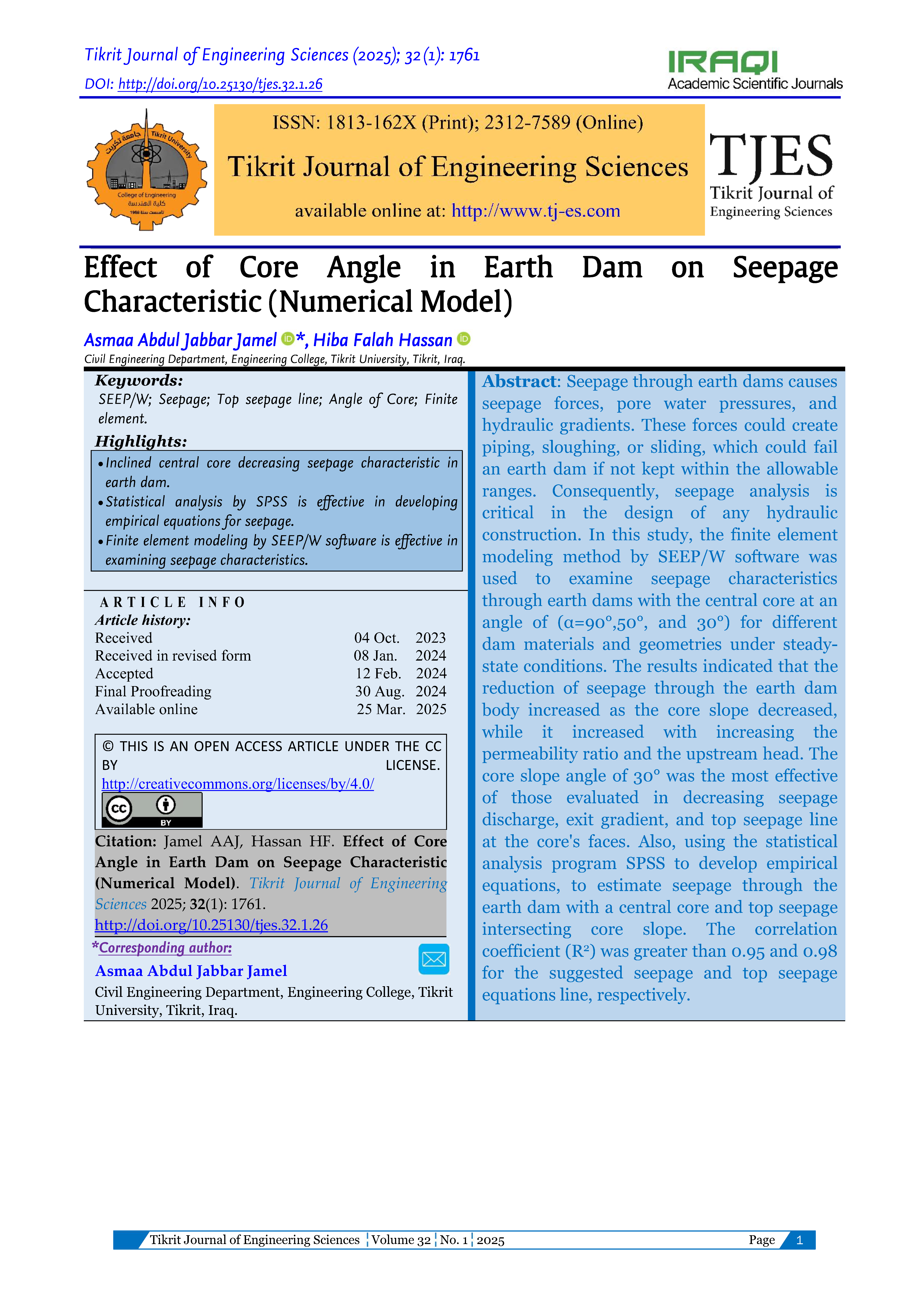Effect of Core Angle in Earth Dam on Seepage Characteristic (Numerical Model)
Main Article Content
Abstract
Seepage through earth dams causes seepage forces, pore water pressures, and hydraulic gradients. These forces could create piping, sloughing, or sliding, which could fail an earth dam if not kept within the allowable ranges. Consequently, seepage analysis is critical in the design of any hydraulic construction. In this study, the finite element modeling method by SEEP/W software was used to examine seepage characteristics through earth dams with the central core at an angle of (α=90°,50°, and 30°) for different dam materials and geometries under steady-state conditions. The results indicated that the reduction of seepage through the earth dam body increased as the core slope decreased, while it increased with increasing the permeability ratio and the upstream head. The core slope angle of 30° was the most effective of those evaluated in decreasing seepage discharge, exit gradient, and top seepage line at the core's faces. Also, using the statistical analysis program SPSS to develop empirical equations, to estimate seepage through the earth dam with a central core and top seepage intersecting core slope. The correlation coefficient (R2) was greater than 0.95 and 0.98 for the suggested seepage and top seepage equations line, respectively.
Metrics
Article Details

This work is licensed under a Creative Commons Attribution 4.0 International License.
THIS IS AN OPEN ACCESS ARTICLE UNDER THE CC BY LICENSE http://creativecommons.org/licenses/by/4.0/
Plaudit
References
Abdel-Kawy A, Aboulatta N, El-Molla D. Effects of Core Characteristics on Seepage Through Earth Dams. Water Practice and Technology 2021; 16(4):1248–1264. DOI: https://doi.org/10.2166/wpt.2021.053
Manual Engineer. Earth and Rock-Fill Dams-General Design and Construction Considerations. US Army 1994.
Omofunmi O, Kolo J, Oladipo A, Diabana P, Ojo A. A Review on Effects and Control of Seepage through Earth-Fill Dam. Current Journal of Applied Science and Technology 2017; 22(5): 1–11. DOI: https://doi.org/10.9734/CJAST/2017/28538
Noori B, Ismaeel K. Evaluation of Valuation of Seepage and Stability of Duhok Dam. Al-Rafidain Engineering Journal 2011; 19(1):42–58. DOI: https://doi.org/10.33899/rengj.2011.27885
Shakir R. Effect of an Impervious Core Constructed into a Large Earth Dam on the Quantity of Seepage. Thi-Qar University Journal of Engineering Science 2011; 2(2): 1-17. DOI: https://doi.org/10.31663/utjes.v2i2.120
Irzooki, R, Jamel A. Experimental Study of Characteristics of Top Seepage Line through Homogenous Earth Dam Using Hele-Shaw Model. International Review of Civil Engineering 2012; 20(10): 1-8.
Moayed R, Rashidian V, Izadi E. Evaluation of Phreatic Line in Homogenous Earth Dams with Different Drainage Systems. 2nd Annual USSD Conference on Innovative Dam and Levee Design and Construction for Sustainable Water Management Civ 2012; Iran.
Talebi M, Vahedifard F, Meehan C. Effect of Geomechanical and Geometrical Factors on Soil Arching in Zoned Embankment Dams. In: Geo-Congress: Stability and Performance of Slopes and Embankments III 2013; 1056-1065. DOI: https://doi.org/10.1061/9780784412787.107
Fattah M, Omran, H, Hassan M. Behavior of an Earth Dam During Rapid Drawdown of Water in Reservoir - Case Study. International Journal of Advanced Research 2015; 3(10): 110–122.
Irzooki, R. Computation of Seepage through Homogenous Earth Dams with Horizontal Toe Drain. Engineering and Technology Journal 2016; 34(3):430–440. DOI: https://doi.org/10.30684/etj.34.3A.1
Zedan, A, Faris M, Abdulsattar A. Seepage Analysis through an Earth Dam (KHASA-CHAI Dam) as a Case Study. Engineering and Technology Journal 2017; 35(2A): 172–181. DOI: https://doi.org/10.30684/etj.2017.127329
Abbas A, Najeeb A. Analysis of Seepage through Embankment Dams as Case Study (Al-Shahabi Dam) in Iraq. International Journal of Sciences: Basic and Applied Research (IJSBAR) International Journal of Sciences: Basic and Applied Research 2018; 40(2): 7–17.
Salem M. Analysis of Seepage through Earth Dams with Internal Core. International Journal of Engineering Research 2019; 8(08): 768–777. DOI: https://doi.org/10.17577/IJERTV8IS080168
GEO-SLOPE International . Seepage Modeling with SEEP/W Calgary.1st ed.; Canada: 2015.
Talukdar P, Dey A. Finite Element Analysis for Identifying Locations of Cracking and Hydraulic Fracturing in Homogeneous Earthen Dams. International Journal of Geo-Engineering 2021; 12(10): 1-26. DOI: https://doi.org/10.1186/s40703-020-00139-8





